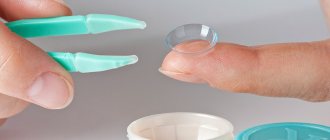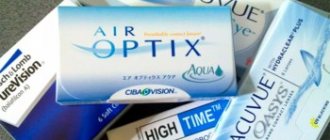Today, contact optics is considered the optimal means of correcting visual pathologies. Innovative technologies and materials make lenses comfortable to use. They do not hinder movement and are not felt on the eyes. But under certain circumstances, optical products can leave negative consequences.
There are many reasons and factors for the occurrence of discomfort during the use of contact lenses, let's consider the main ones, as well as the consequences and eye diseases that may appear in the process.
What can be the consequences of wearing lenses?
The consequences of long-term wearing of contact lenses can be either easily corrected or very severe, causing serious eye diseases. Often the situation is complicated by the fact that at the initial stages it is difficult to determine the true cause of discomfort, which may lie in eye pathology and the characteristics of the selected lenses: their material, type, gas permeability and moisture content. The most common consequences of using contact optics include:
- Swelling of the cornea;
- Excessive deposition of protein formations on the surface of the lenses;
- Conjunctivitis;
- Dry eye syndrome;
- Proliferation of blood vessels;
- Keratitis;
- Corneal ulcer;
- Allergic reactions.
Let's look at each of them in more detail.
Contraindications to wearing contact lenses
Home / Articles / Contraindications to wearing contact lenses
The main medical contraindications to the prescription of contact lenses for vision correction are mostly relative. The overwhelming majority are acute or chronic inflammatory diseases of the anterior segment of the eye.
These include recurrent keratitis, for example, herpetic, scleritis, uveitis, in which mechanical irritation and hypoxia caused by wearing lenses can aggravate the disease.
In case of acute inflammatory diseases (conjunctivitis, keratitis, styes, etc.), wearing contact lenses is stopped until cured. In chronic processes, contraindications to contact correction should be considered relative. Particular attention should be paid to such a very common disease as marginal blepharitis. More often observed is the so-called anterior blepharitis, which is classified into staphylococcal and seborrheic. The first type of blepharitis is caused by staphylococcus; Chronic inflammation of the hair follicle, epidermal ulcerations, and tissue destruction develop. In the second type of blepharitis, the glands of Zeiss and Moll are affected. At the same time, yellowish sebaceous scales are observed along the edge of the eyelashes after removal of which, unlike staphylococcal blepharitis, no ulceration is observed. The clinical picture and complaints of patients with both types of marginal blepharitis are very similar - itching, burning in the eyes, foreign body sensation, slight photophobia, dry eyes, hyperemia of the eyelid margins. Secondary complications often occur - chronic conjunctivitis, point corneal epitheliopathy. The course of the disease is chronic, accompanied by exacerbations and remissions. Treatment: for staphylococcal blepharitis - local antibiotics, cleansing the edges of the eyelids using special wipes (for example, Ocusoft), artificial tears.
Posterior marginal blepharitis is caused by inflammation of the meibomian glands, has a similar clinical picture, and also occurs chronically with exacerbations and remissions. Treatment is massage of the meibomian glands, local antibiotics.
Parasitic diseases of eyelashes, caused mainly by Demodex mites, have become very widespread. Thus, in the USA, this pathology was found in 58% of the population aged 26 to 50 years and in 67% of the population aged 51 to 90 years (Efron N., 1998). Various types of mites are localized in the hair follicles of the eyelashes or the glands of Zeiss and Moll. The clinical picture of the disease caused by these parasites is similar to anterior marginal blepharitis. The course is often subclinical, chronic with exacerbations, although severe forms of the disease also occur. Treatment consists of removing mites as much as possible mechanically (special scrub systems, wipes soaked in ether, etc.) followed by rubbing in ointments (for example, yellow mercury).
For these diseases, wearing contact lenses if they are tolerated satisfactorily is not contraindicated, but in case of exacerbations, wearing lenses is stopped for the duration of treatment, which usually lasts 2-3 weeks.
Particular attention should be paid to patients with microsymptoms of dry eye syndrome, which are often diagnosed as chronic conjunctivitis. In these conditions, as mentioned above, lens intolerance may occur due to disruption of the stability of the tear film. Therefore, in cases of intolerance to contact lenses, the condition of the lacrimal apparatus and tear fluid (tear production, time of tear film rupture, etc.), meibomian glands should be especially carefully examined and, if necessary, appropriate treatment should be carried out. For blepharitis and microsymptoms of dry eyes, more frequent cleaning and disinfection of lenses or the use of daily lenses and contact lenses with a high moisture content of more than 50%, as well as the use of artificial tear-based eye drops, are recommended.
Particular attention should be paid to chlamydial conjunctivitis - paratrachoma, which has recently become widespread, especially among young people. Chlamydial conjunctivitis accounts for 10 to 14% of all conjunctivitis. The duration of the disease in case of untimely diagnosis and ineffective treatment can reach 3-6 months. Chlamydial conjunctivitis is associated with urogenital chlamydial infection, which is often asymptomatic.
The transfer of pathogens is carried out by contaminated hands from the infected genitourinary organs of the patient. Limiting the possibility of autoinfection, i.e. transfer of infection from a diseased eye to a healthy one confirms that the disease mainly affects one eye. Less commonly, the pathogen enters the eye with water from stagnant waters (swimming pools). Typically, chlamydial conjunctivitis is diagnosed very late, after 2-3 months of unsuccessful treatment for allergic or viral conjunctivitis.
The clinical picture of these conjunctivitis is expressed in severe hyperemia and pronounced swelling of the eyelids, narrowing of the palpebral fissure, and pseudoptosis. Typical for paratrachoma are large, loose follicles located in rows in the lower fornix, which later merge in the form of 2-3 ridges. The discharge is insignificant, mucopurulent in nature. Subsequently, damage to the upper limbus occurs (hyperemia, swelling, vascularization) in the form of micropannus, and multiple pinpoint subepithelial infiltrates, similar to adenovirus infection, appear on the cornea. As the disease progresses, the pannus becomes more pronounced and spreads to 1/3 of the cornea. On the cornea in the limbal region, gray infiltrates of a round shape and superficial ingrowth of blood vessels into the limbal region are observed.
Characteristic of paratrachoma is the appearance of regional pre-auricular adenopathy on the side of the affected eye from 3-5 days, enlarged lymph nodes that are painful on palpation, and decreased hearing on the side of the affected eye.
There is no ideal laboratory diagnostic test for eye infections. It is recommended, for example, direct examination from smears or scrapings - cytoplasmic immunofluorescence or enzyme immunoassay.
Currently, a recommended treatment method includes a 10-day course of maxaquin (lomefloxacin) 1 tablet (400 mg) once a day in combination with one of the local therapy drugs. The following drugs are used locally: Eubetal ointment - 4-5 times a day; Colbiocin ointment - 4-5 times a day; 0.3% Okacin eye drops (lomefloxacin) - 5-6 times a day. If the dynamics are positive during the treatment, the number of instillations of drops or ointment applications decreases every subsequent week.
It is advisable to combine the use of Okacin eye drops or Kolbiocin ointment with anti-inflammatory therapy: starting from the second week, add instillations of dexamethasone eye drops for 1 week 1 time per day, then 2 times a day. It is recommended to prescribe SCL 6 months after complete cure.
For recurrent iritis and iridocyclitis, the issue of wearing contact lenses is decided individually after a trial wearing of the lens, and also depending on the frequency of relapses, the clinical picture of the disease and other factors.
Lenses are contraindicated in cases of obstruction of the lacrimal ducts and dacryocystitis. In these cases, preliminary therapeutic or surgical treatment is recommended.
In the presence of pterygium or pinguecula, the selection of contact lenses is difficult due to the fact that these formations are a mechanical obstacle to the movement of the lens. Surgical treatment is recommended.
For corneal dystrophies, contact lenses are prescribed, although the issue of tolerability of the lenses is finally decided after wearing them for a trial.
Of the common diseases, mental illnesses are contraindications for wearing contact lenses.
It should be noted that poor tolerability of lenses can be observed in patients with diabetes, during pregnancy, menstruation, and menopause (due to dry eye syndrome); The tolerance of lenses in hot climates and dusty atmosphere deteriorates.
Failure to comply with hygiene rules when using contact lenses can also lead to complications.
It is important to note that often refusal of contact lenses and poor tolerance are observed with insufficient motivation to wear contact lenses.
from the book “Contact vision correction.” Kivaev A.A., Shapiro E.I.
Corneal edema
A deviation such as corneal edema most often occurs due to an insufficient amount of oxygen supplied to the visual organs, which may be directly related to incorrectly selected curvature of the optical product (an individual parameter for each patient), their nighttime use during sleep, overwear or material characteristics.
The main signs of corneal edema are: blurred image, “rainbow” when looking at bright light, pain during prolonged use of lenses, redness.
This consequence can be eliminated in a few days if you consult a specialist in a timely manner.
Carrying out keratometry
Keratometry provides the specialist with information about all the individual parameters of the eye, for example, the radius of curvature of the cornea in its maximum and minimum meridians, expressed in millimeters and diopters.
Next, during biomicroscopy (examination using a slit lamp), the horizontal diameter of the cornea is determined, and the shape of the cornea, which should normally be spherical, the vertical height of the palpebral fissure, and the condition of the tear film are assessed. Also, using a slit lamp, a specialist can record existing complications from wearing contact lenses.
Formation of protein deposits
A very common manifestation, which is quite natural when wearing optical products with a long period of use. The fact is that the proteins, lipids and calcium that make up the tear fluid come into direct contact with the surface of the lenses.
When the components of tear fluid accumulate on the surface of the lens, a non-uniform film appears, it can distort vision and cause irritation of the visual organs, itching and redness.
If the user does not follow the rules of hygiene and lens care, infectious eye diseases may occur. That is why experts strongly recommend daily cleaning of optical products with a multi-purpose solution that contains special enzymes to eliminate such deposits.
If the problem of lipid and protein formations occurs too often, it is better to use contact optics made from materials containing Comfilcon A or Netrafilcon A, which make the surface of the lenses more resistant to the accumulation of proteins and lipids. It is also worth considering daily replacement products that do not require maintenance. At the end of the day, you dispose of your used pair and put on a new pair in the morning. In a short period of wearing, such formations do not have time to appear on the surface of the product, so any danger is excluded.
It is very important to understand that protein deposits are a potential cause of various infections, and their rough surface can cause microtrauma to the cornea.
Contraindications for the visual organs
First of all, contraindications for lenses are diseases and defects of the visual organs.
Inflammatory diseases
The following is an incomplete list of inflammatory diseases for which wearing contact lenses is contraindicated. After treatment and complete recovery, which will be confirmed by an ophthalmologist, the patient will be able to return to contact vision correction.
So, you will have to temporarily abandon the lenses if the inflammation affects:
- Eyelid margins – blepharitis;
- The mucous membrane of the eye – conjunctivitis;
- Lacrimal sac – dacryocystitis;
- The choroid of the eye – uveitis;
- Sclera – scleritis;
- Cornea – keratitis;
- Anterior segment of the eye – iridocyclitis.
What happens if you use contact lenses while sick? Inflammatory processes can worsen due to lack of oxygen and mechanical irritation of the mucous membrane, and under the lens, especially without proper care, a favorable environment is created for the growth and development of bacteria. This can lead to the fact that the acute form of the disease becomes chronic or severe complications arise, the treatment of which will require surgical intervention.
Inflammatory diseases are a temporary but strict contraindication to wearing contact lenses
If the disease has already become chronic, it is not recommended to use contact lenses during periods of exacerbation. As for wearing lenses during periods of remission, when there are no obvious manifestations of the disease, the decision remains with the ophthalmologist - each such case requires an individual approach.
Visual impairment and non-inflammatory diseases
Separately, we should highlight a number of conditions of the visual system that are not strict contraindications to wearing contact lenses, but require an integrated approach from an ophthalmologist.
- Strabismus, but provided that the deviation angle is 15 degrees or more. If the deviation angle is less, the use of contact lenses is permissible, but only after consulting an ophthalmologist - the doctor will evaluate the condition of the eyes and make a final decision;
- Chronic dryness;
- Lens subluxation;
- Ptosis of the eyelid;
- Violation of the composition of the tear fluid.
In these conditions, the ophthalmologist not only determines the possibility of wearing contact lenses, but also prescribes appropriate treatment. The patient is offered additional measures to ensure comfort when wearing lenses, if it is possible to select them. For example, this could be surgical treatment.
Conjunctivitis
This eye disease from lenses can occur due to the presence of allergens in the composition of care products, as well as accumulated protein formations and other contaminants (for example, cosmetic residues). Conjunctivitis appears as a small bulge at the top of the eyelid. Signs of pathology: itching, lacrimation, irritation, sensation of a foreign object in the eye.
To eliminate capillary conjunctivitis, it is recommended to avoid the use of contact lenses until the problem is completely resolved. The specialist will help you select other optical products based on the material, prescribe medications that prevent the development of mast cells, and drops that eliminate discomfort.
How to use contact lenses?
Before putting the SCL on your eyes, you need to wash your face and hands with soap and water, then dry thoroughly. Any optics manufacturer must include an instruction manual with its product, which contains a schematic representation of the order of actions that you have to perform. Follow the prompts and in a few seconds the lenses will be in place.
In the evening, before going to bed, the SCL should be carefully removed, also based on the attached manual, and stored in a special solution. It has a standard composition and is sold in all major optical stores. However, it is worth clarifying which drug is best suited for your type of SCL. Both the solution and the plastic lens storage container itself must be replaced every 3-6 months.
If, while wearing contact lenses, you find signs of acute respiratory viral infection, flu, or bacterial infection of the upper respiratory tract, immediately remove the contact lenses and do not resume using them until you have completely recovered!
Otherwise, you will very easily get an infection in your eyes. It is unnecessary to talk about the need to contact an ophthalmologist in case of existing symptoms of eye inflammation - this goes without saying. In addition, you should be alert to any manifestations of discomfort directly or indirectly associated with MCL, ranging from lacrimation to headaches. Perhaps the lenses do not suit you or no longer suit you. An urgent visit to an ophthalmologist is required by situations such as sudden progressive deterioration of vision, pain and swelling in the eyeballs, and a sharp worsening of asthenopic syndrome.
Dry eye syndrome
Very often, users who wear contact lenses for a long time develop dry eye syndrome or, as experts call it, keratoconjunctivitis. As a rule, the disease occurs due to prolonged and intense work at the computer, being in a room with dry air and a deficiency in the production of tear fluid by the visual system.
To eliminate discomfort, doctors prescribe medications containing the same components as human tears (for example, hyaluronic acid).
On the modern optics market, there are special lenses that eliminate the symptoms of the disease, which are created specifically for sensitive eyes and are able to retain moisture on the surface for as long as possible. It is also advisable for people with dry eye syndrome to use additional moisturizing drops and gels.
Pre-examination survey
During the survey, the doctor determines:
- The reason why the patient wants to wear contact lenses (complaints about blurred vision, sports, profession, desire to change his image)
- How often does the patient want to wear contact lenses (constantly, occasionally, continuously for a long time, etc.)
- Previous vision correction (none, glasses, contact lenses)
- General information about the state of health, the presence of allergies and the use of medications is clarified (some drugs affect the quality and quantity of tear fluid, as a result leading to the rapid formation of deposits on the lens)
Vessel proliferation on the cornea
Due to improperly selected soft contact lenses, proliferation of blood vessels on the cornea of the visual organs can occur. The reason for this is the insufficient amount of oxygen supplied to the cornea. This consequence is often associated with the use of contact optics with daytime mode during sleep. If the user needs to sleep in optical products, it is worth choosing night lenses, that is, with a flexible or prolonged mode of use.
Are colored contact lenses dangerous?
Colored lenses are no more dangerous than regular ones. However, they are often not taken seriously and the first ones available are taken, although the selection of such lenses should be carried out by a doctor, because wearing them is no different from wearing contact lenses that correct vision.
These rules do not work for scleral colored lenses, which completely cover the visible part of the eyeball (and the tissues do not receive enough oxygen). Since these lenses are not registered in Russia (as in many other countries), when buying them on the Internet, you risk receiving a product that is hazardous to your health and has not been tested by regulatory authorities.
A couple of important facts about contact lenses:
- The contact lens cannot move behind the eyeball: the eye is designed so that it remains on the visible part of it. It’s just that sometimes a contact lens can fold and this will lead to a long search for it, especially for beginners.
- Contact lenses cannot stick to the eye in the cold. In any weather, the eyeballs have a temperature that is definitely different from zero, so the lenses will always remain in normal condition and will not freeze. However, in winter, air humidity is very low, lenses can dry out faster, which will lead to some discomfort.
Microbial keratitis
This complication is one of the most dangerous and can lead to complete loss of visual ability. Despite the fact that the visual apparatus is designed in such a way that it independently prevents infection by washing the cornea with tear fluid, obsolete cells die off during its functioning and can remain on the surface of the lenses.
The occurrence of microbial keratitis can occur in people who continuously wear night lenses; the consequences are the appearance of microorganisms such as staphylococcus or Pseudomonas aeruginosa. Patients experience profuse lacrimation, burning, photophobia, and purulent discharge.
Corneal ulcer
The disease is often infectious in nature and is accompanied by severe pain, discharge of purulent formations, and lacrimation.
An ulcer can appear if hygiene rules are not followed, lenses are worn for longer than the period specified by the manufacturer, and the cornea is damaged.
Sometimes a person even has a hole in the affected area. The rate of disease progression depends on the type of microorganisms that appear in the visual system. There is also a sterile manifestation of a corneal ulcer; it is mild and without pain symptoms; as a rule, the patient is not aware of its existence in the early stages of development.
Allergy
Allergic eye reactions can occur to the material from which contact optics are made, or to components contained in lens care products.
If allergic reactions occur, ophthalmologists recommend either choosing other lenses or replacing the solution with a hypoallergenic one, without adding preservatives.
Formations on the surface of optical products can also become strong allergens; subsequently, such an allergy develops into conjunctivitis, accompanied by itching, photophobia, corneal edema, and lacrimation.
Stages of patient examination
Conducting tests for tear production and drainage. To ensure that wearing contact lenses does not cause complications, primary patients need to undergo a full range of functional tests for tear production and drainage.
Selecting a contact lens. If the medical history and test results are not grounds for refusing to prescribe soft contact lenses to the patient, the doctor proceeds to a very important stage of the examination: helping the patient choose the type of lens, wearing mode and frequency of replacement. The most important property of a polymer contact lens material is its ability to transmit oxygen. Currently, five types of silicone gyrogel soft contact lenses are produced. All these lenses, when worn during the day, satisfy the cornea's need for oxygen. If the patient is committed to long-term use of contact lenses for vision correction, then he should know that only when wearing silicone hydrogel soft contact lenses can he count on complete safety and a high level of comfort. The majority of doctors believe that these lenses are best worn during the day, despite the permission of the FDA (US Food, Drug and Cosmetic Administration) and the Ministry of Health of the Russian Federation not to remove the lenses at night (from 6 to 30 days) . With this approach, several very important properties of silicone hydrogel contact lenses remain unclaimed: single use, prevention of mechanical complications, no need for treatment in a multifunctional solution (prevention of allergic reactions and autosensitization). By the way, we note that the only solution designed specifically for disinfecting silicone hydrogel soft contact lenses is Opti-Free RepleniSH from Alkon, which is not yet available to Russian consumers.
Observations of patients who used Focus Night & Day lenses for 7 years in a continuous wearing mode showed that the wearing mode proposed by CIBA Vision met the expectations that patients and doctors had for it. In addition, these lenses have been recommended by the FDA since 2006 for therapeutic use in hypoxic keratopathy induced by long-term use of hydrogel soft contact lenses. The range of applications of lenses for medicinal purposes today is already quite wide and, thanks to its unique properties, will continue to expand. If the patient wants to continue wearing glasses and only in exceptional cases needs vision correction with contact lenses, daily lenses are more suitable for him.
Each soft contact lens has several standard parameters: diameter, radius of curvature, optical power. These characteristics can be read on the box (Fig. 1, 2) and on the blister (Fig. 3). The blister also indicates the expiration date of the lens, describes the characteristics of the material from which it is made, and in addition, there is a warning that the lens can only be used as prescribed by a doctor. The inscription Not for individual sale means that the lens is not sold in blisters. Most soft contact lenses have a marking (side index). It is located on the outside of the lens and is read clockwise (Fig. 4).
Rice. 1. Characteristics of lenses indicated on the cardboard packaging for SCLs: 1 - radius of base curvature; 2 - diameter; 3 - optical power of the lens
Rice. 2. Information placed on cardboard packaging for SCL: 1 - description of the contents of the package, information about the polymer material, its moisture content; 2 - a sign indicating that the lens can be sold only with a doctor’s prescription; 3 - approval for the use of lenses for vision correction by the European Committee
Rice. 3. SKL blister pack: 1 - barcode; 2 — optical power, radius of base curvature, diameter; 3 — lot number, expiration date; 4 — name of the lens; 5 - a sign indicating that the lens can only be sold with a doctor’s prescription
Rice. 4. Marking of the outer surface of the lens
The lens diameter is selected based on autorefractometry data.
The physician's choice of the radius of curvature of the lens may be based on an assessment of the position of the fitting lens. Currently, the bulk of new lenses with an aspherical inner surface design have one radius of curvature (Acuvue Oasis - 8.4 mm; O2Optix - 8.6 mm; Focus Dailies - 8.6 mm) and a diameter of 14.2 mm. The combination of these parameters makes the lens universal and suitable for the vast majority of users.
Patient education. The process of teaching a patient how to manipulate soft contact lenses begins with a story about the rules for disinfecting lenses, how to put them on and take them off, and emergency conditions when wearing soft contact lenses that require urgent medical attention.
Vertex correction. When selecting soft contact lenses based on the data of an autorefractometer, phoropter and trial spectacle lenses, the doctor uses a table for taking into account the vertex correction in comparing a spectacle lens and a soft contact lens.
| Determination of vertex correction for soft contact lenses | ||
| Spectacle lenses of positive and negative refraction, diopters | Contact lenses | |
| negative refraction, diopter | positive refraction, diopter | |
| 3,00 | -2,90 | +3,11 |
| 3,25 | -3,13 | +3,38 |
| 3,50 | -3,36 | +3,65 |
| 3,75 | -3,59 | +3,93 |
| 4,00 | -3,82 | +4,25 |
| 4,25 | -4,04 | +4,50 |
| 4,50 | -4,25 | +4,75 |
| 4,75 | -4,50 | +5,00 |
| 5,00 | -4,75 | +5,25 |
| 5,50 | -5,16 | +5,89 |
| 6,00 | -5,60 | +6,50 |
| 6,50 | -6,00 | +7,00 |
| 7,00 | -6,50 | +7,62 |
| 7,50 | -6,87 | +8,25 |
| 8,00 | -7,25 | +8,87 |
| 8,50 | -7,75 | +9,50 |
| 9,00 | -8,12 | +10,12 |
| 10,00 | -8,93 | +11,36 |
| 11,00 | -9,72 | +12,75 |
| 12,00 | -10,50 | +14,00 |
| 13,00 | -11,25 | +15,50 |
| 14,00 | -12,00 | +16,75 |
| 15,00 | -12,75 | +18,25 |
| 16,00 | -13,50 | +19,75 |
| 17,00 | -14,12 | +21,50 |
| 18,00 | -14,75 | +23,00 |
Patient examinations. The frequency of control examinations during dynamic monitoring of patients using contact lenses is determined by the doctor, taking into account the individual characteristics of the patient. The first examination of primary patients is necessary to assess the initial adaptation to conditions of relative hypoxic stress of the cornea one hour after lens insertion. Then it is recommended to examine patients after the first week of wearing lenses, after 1 month, after 3 months, and then constant dynamic monitoring is required once every 3-6 months.
For the period of adaptation to silicone hydrogel soft contact lenses, it is mandatory to wear lenses in daytime mode, increasing the duration of wear by 2 hours a day from 4 to 16 hours. The first examination is necessary after the first continuous daily wearing of the lens.
The scope of the dispensary examination includes determination of distance visual acuity with and without lenses, autorefractometry, assessment of the position of the lens on the eye, its mobility, deposits on the front surface of the lens, hypoxic signs, biomicroscopy of the cornea and limbus area under high magnification. If it is necessary to carry out a course of treatment for conjunctivitis, blepharitis, keratopathies, etc., wearing soft contact lenses must be avoided until complete recovery.
These lenses have been available on the Russian market since 1999.
Based on materials from the article “Standardization and optimization of ophthalmological examination of patients. Part 2. Prescription and selection of contact lenses" S.A. Novikov, A.A. Koltsov, Modern Optometry No. 2 February-March 2007
Other related articles:











